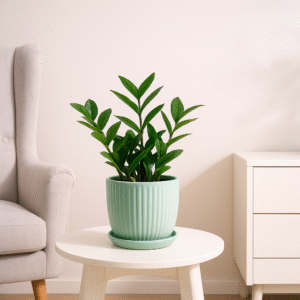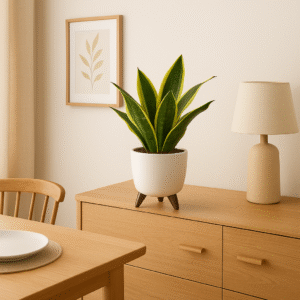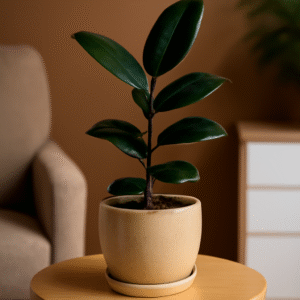Not every home has the luxury of bright windows or balconies that receive hours of direct sunlight. Many Indian apartments, especially in metro cities, face shaded courtyards, tall neighboring buildings, or north-facing balconies where natural light is limited. But that doesn’t mean you can’t enjoy the beauty of indoor plants.
There are plenty of low-light indoor plants that thrive perfectly well in such conditions, making them ideal for Indian homes. These plants not only adapt to minimal sunlight but also improve air quality, reduce stress, and make your home more inviting.
In this blog, we’ll explore the 7 best low-light indoor plants, their care tips, and how you can decorate your home with them.
Why Choose Low-Light Indoor Plants?
- Perfect for apartments and offices with limited natural light.
- Air purifiers that remove toxins and improve indoor air quality.
- Low-maintenance options for busy lifestyles.
- Aesthetic value – they bring greenery even to darker corners of your home.
1. Snake Plant (Sansevieria trifasciata)
One of the most popular low-light plants, the snake plant is known for its upright, sword-shaped leaves. It can survive almost anywhere and is perfect for beginners.
Care Tips:
- Thrives in low to bright indirect light.
- Water only when the soil is completely dry.
- Extremely drought-tolerant, so don’t overwater.
Why It’s Great for Indian Homes:
Snake plants are hardy and can withstand India’s varying climates while still being excellent air purifiers.
2. ZZ Plant (Zamioculcas zamiifolia)
The ZZ plant has glossy, dark green leaves and is one of the toughest indoor plants. It grows well even in very dim corners of the house.
Care Tips:
- Tolerates very low light.
- Water sparingly; it stores water in its rhizomes.
- Dust leaves occasionally to keep them shiny.
Why It’s Great for Indian Homes:
With its minimal care needs, the ZZ plant is ideal for offices, bedrooms, and living rooms with little sunlight.
3. Peace Lily (Spathiphyllum)
Known for its elegant white flowers and air-purifying qualities, the peace lily thrives in semi-shade and low-light conditions.
Care Tips:
- Prefers indirect sunlight or fluorescent light.
- Water when the soil feels slightly dry.
- Mist occasionally to maintain humidity.
Why It’s Great for Indian Homes:
Peace lilies add both greenery and occasional blooms, brightening up shaded corners.
4. Pothos (Epipremnum aureum / Money Plant)
A favorite in Indian homes, the pothos—or money plant—is versatile and grows well in low to medium light. It can trail from shelves or be trained to climb.
Care Tips:
- Survives in low-light areas but grows faster in bright indirect light.
- Water 2–3 times a week depending on season.
- Can grow in both soil and water.
Why It’s Great for Indian Homes:
Easy to grow and propagate, pothos adds instant greenery and is believed to attract positivity.
5. Spider Plant (Chlorophytum comosum)
Spider plants are adaptable, low-maintenance, and grow well in low to moderate light. Their arching leaves and baby offshoots make them visually appealing.
Care Tips:
- Prefers indirect light but tolerates shade.
- Water moderately; do not let soil stay soggy.
- Trim brown tips to maintain appearance.
Why It’s Great for Indian Homes:
Spider plants are pet-friendly and excellent air purifiers, perfect for family homes.
6. Chinese Evergreen (Aglaonema)
Chinese evergreen plants are known for their colorful foliage with shades of green, red, or silver. They thrive in very low-light conditions.
Care Tips:
- Tolerates low to medium light.
- Water when the topsoil feels dry.
- Avoid cold drafts and direct sun.
Why It’s Great for Indian Homes:
Adds a splash of color while being very easy to maintain, perfect for indoor décor.
7. Lucky Bamboo (Dracaena sanderiana)
Often grown in water-filled containers, lucky bamboo is associated with good fortune and positivity in Indian households.
Care Tips:
- Thrives in low-light spaces.
- Change water every 2 weeks if grown hydroponically.
- Use filtered water to prevent yellowing leaves.
Why It’s Great for Indian Homes:
Compact and stylish, lucky bamboo is perfect for desks, shelves, and small spaces.
Comparison Table: Low-Light Indoor Plants for Indian Homes
| Plant Name | Light Requirement | Watering Needs | Air Purifying | Difficulty Level | Ideal Placement |
|---|---|---|---|---|---|
| Snake Plant | Low to indirect light | Every 2–3 weeks | Yes | Very Easy | Bedroom, Living Room |
| ZZ Plant | Very low light | Once every 2–3 weeks | Yes | Very Easy | Office, Low-lit Corners |
| Peace Lily | Low to medium light | Weekly | Yes | Moderate | Living Room, Bedroom |
| Pothos (Money Plant) | Low to indirect light | 2–3 times a week | Yes | Easy | Balcony, Hanging Planters |
| Spider Plant | Low to medium light | 2–3 times a week | Yes | Easy | Kitchen, Balcony |
| Chinese Evergreen | Very low light | Weekly | Yes | Easy | Living Room, Entryway |
| Lucky Bamboo | Low light | Every 2 weeks (water) | Moderate | Easy | Office Desk, Study Table |
Tips to Care for Low-Light Indoor Plants
- Avoid overwatering – most low-light plants prefer drier soil.
- Rotate pots occasionally so all sides get light.
- Clean leaves to help photosynthesis.
- Use well-draining soil and pots with drainage holes.
- Add fertilizer once a month during the growing season.
Where to Buy Low-Light Indoor Plants Online
At The Tarva, we bring you the best collection of indoor plants perfect for Indian homes, including low-light favorites. Explore thetarva.com for:
- Snake Plants – hardy air purifiers.
- Money Plants – for prosperity and greenery.
- ZZ Plants – thrive in very low light.
- Peace Lilies – for beauty and blooms.
- Spider Plants – pet-friendly and easy-care.
Each plant is delivered healthy, well-potted, and ready to brighten up your shaded spaces.
Conclusion
Low-light doesn’t mean no greenery. With plants like snake plants, ZZ plants, peace lilies, and money plants, you can easily transform dark corners of your Indian home into lively, healthy spaces. These low-maintenance varieties are perfect for urban lifestyles and bring nature’s benefits right into your living room, bedroom, or office.
If you’re ready to start your indoor garden, choose a few low-light champions and let your home glow with greenery.




